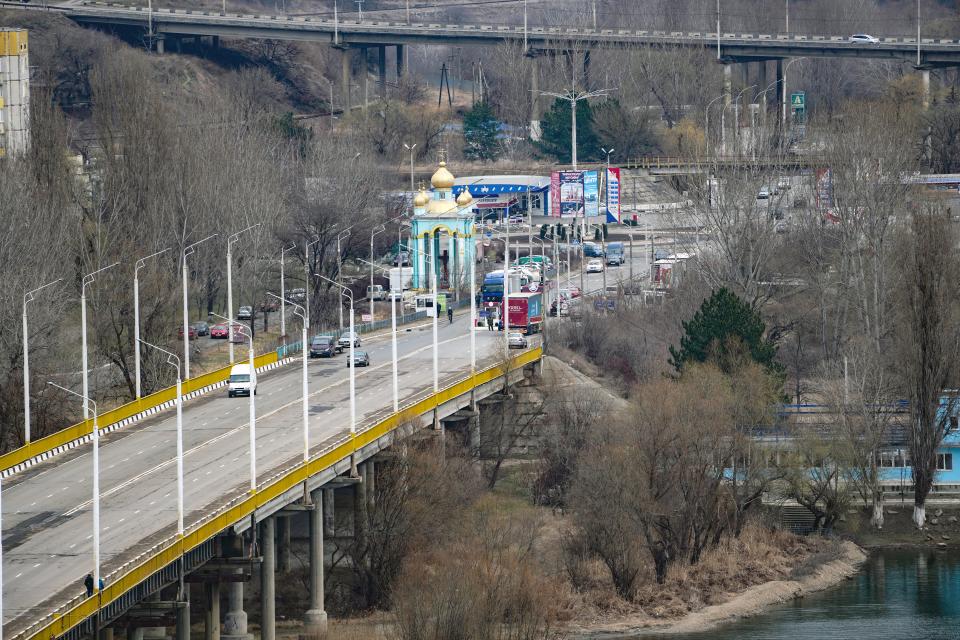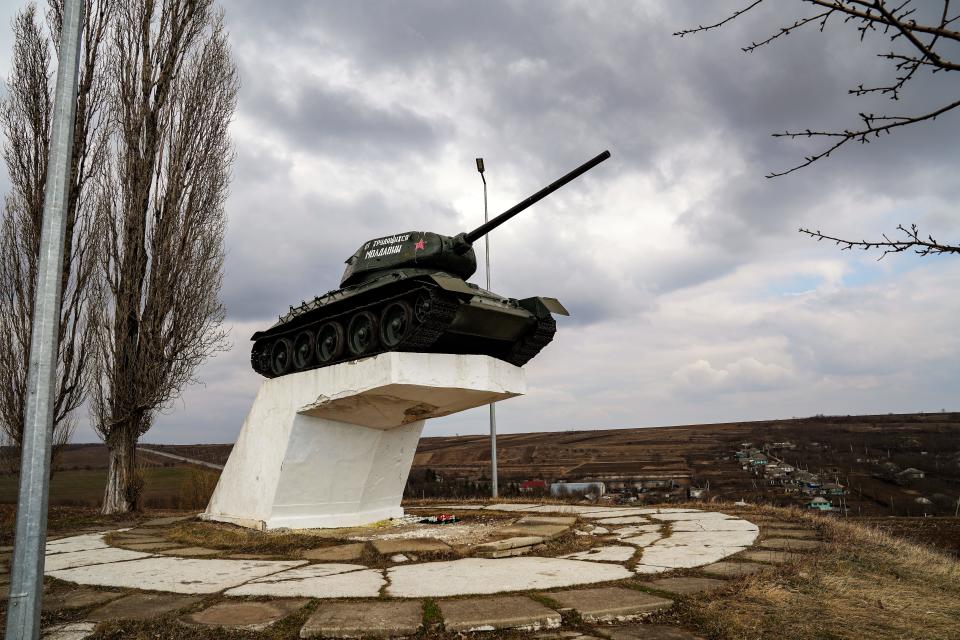Transnistria is just a sliver of land between Moldova and Ukraine. But it's becoming a focus of war.
REZINA, Moldova — The Russian-uniformed border guard holds out his hand and the truck driver hands over his passport and other documents — a routine and otherwise unremarkable transaction except that it's happening hundreds of miles from Russia.
Instead, it's taking place within the tiny European country of Moldova, at the border of the Russia-aligned territory known as Transnistria, which is home to an estimated 20,000 tons of Soviet-era weapons, ammunition and explosives, and more than 1,000 Russian troops. Transnistria sits on the Ukraine border and its neighbors have long worried that Russia would use it as a staging area for an invasion either east into Ukraine or west into Moldova. A series of explosions within Transnistria this week have further heightened concerns.
"It's the reality we're seeing, the surreal reality. That's what really worries a lot of people," said Olena Khorenjenko, 33, a Ukrainian refugee who fled to Moldova and is familiar with Transnistria. "These are our neighbors — not some faraway people."
LATEST UPDATES: Russia shuts off gas to Poland and Bulgaria, US diplomats begin the return to Ukraine
Video: NGO evacuating women and children from Ukraine to Moldova
Americans, especially American journalists, aren't welcome in the breakaway region, but even from the border it's easy to see the Russian influences: guards wear Russian-style camouflage, Cyrillic words are written on buildings across the Dniester River from Rezina in Moldova, and even the Soviet-style hammer and sickle is on the flag.
Transnistria gets its name from being on the east side of the Dniester River, and it occupies a long, narrow slice of land alongside Ukraine. Transnistria is smaller than Delaware, and Moldova as a whole is about the size of Maryland.
.oembed-frame {width:100%;height:100%;margin:0;border:0;}
On Monday night, explosions struck the headquarters of Transnistria security forces, who are paid by Russia. More explosions Tuesday destroyed transmission towers used for Russian broadcasts. Moldovan officials said the Monday explosions were caused by grenade launchers.
The explosions came days after a Russian commander suggested that the Ukraine invasion was part of an effort to end oppression of Russian-speaking people in Transnistria, which experts widely consider to be a pretext. The building hit by explosions was empty because it was a public holiday, although Transnistrian media reported that some windows in surrounding homes were broken by the blast.
Moldovan officials said the attacks were designed "to create pretexts for tensioning the security situation" in the disputed area.
Like many Ukrainians, Khorenjenko worries that Russia will annex Transnistria the way it did the Crimea or the Donbas regions. Few Moldovans visit the area, and many treat it with deep suspicion due to its Russian ties. The Russian soldiers remain there primarily to guard the ammunition depot, left behind as the Soviet army withdrew from Europe at the end of World War II, and to protect a polluting steel foundry that belches smoke over the area.

Transnistria broke away from Moldova during the collapse of the Soviet Union in the early 1990s, and the region is home to people who are linked almost equally to Russia, Romania and Moldova.
Although the United Nations doesn't recognize Transnistria as its own country, about 500,000 people live there, and the territory has its own money and an official name: The Pridnestrovian Moldovan Republic.
Transnistrians are in some ways a throwback to the idea of the Soviet Union, said Keith Harrington, an Irish scholar who studies the area: "They try to hold onto the Soviet idea that you have an ethnic identity but that you identify with the region as well."

Harrington, who has visited Transnistria regularly, said most visitors wouldn't notice a significant difference from being in Moldova, as many of the "Russian" border guards and soldiers were born locally, rather than transferred in from Russia, the way the Soviet Union handled things.
"Most of those troops are people who are born in Transnistria and have Russian citizenship. They're not really Russian troops," Harrington said. "And from what I've heard, there's no appetite for those armed forces to get involved in the Ukraine conflict."
A port city, a steel cage, a palace: The steps that made Putin 'the richest man in the world'
Many Moldovans today view Transnistria with a concern that borders on outright fear, although they're reluctant to discuss those views publicly, in part because they worry Russian intelligence agents might target them, especially if President Vladimir Putin decided to attack Moldova. While visiting the area, a USA TODAY reporter spoke with more than a dozen Moldovan professionals, translators, nonprofit leaders and others familiar with Transnistria..
Moldovan officials have long treated Transnistria with caution over fears Russia could invade or occupy it like it has in Ukraine or Crimea or Donetsk.

In a press conference Tuesday, Moldovan President Maia Sandu reiterated her longstanding commitment to a peaceful relationship with Transnistria. Shortly after Russia invaded Ukraine, Sandu formally requested membership in the European Union, which could eventually bring the small country military protection from other E.U. members if requested.
Philip Remler, a former U.S. State Department official who worked extensively in Eastern Europe, Russia and Moldova, said Russia has a long track record of encouraging breakaway areas, from Transnistria to Abkhazia and South Ossetia and Crimea.
Other experts said they see Russia's involvement in Transnistria as largely driven by a desire to frustrate Europe.
"There’s a Russian playbook in these cases — Moscow encouraged separatism as a weapon, and protected the separatists, and while refusing to recognize them as states, gave them some legitimacy as political entities in their own right," said Remler, a nonresident scholar at the Carnegie Endowment for International Peace.
Remler said Russia has never seemed particularly serious in its interest in Transnistria, "and it’s an interest that, I believe, the Transnistrians would rather do without."
More: As Russia escalates attacks, what a new phase of war means for Ukrainians in the east

This article originally appeared on USA TODAY: Transnistria, Moldova get new focus amid Russia's Ukraine invasion

